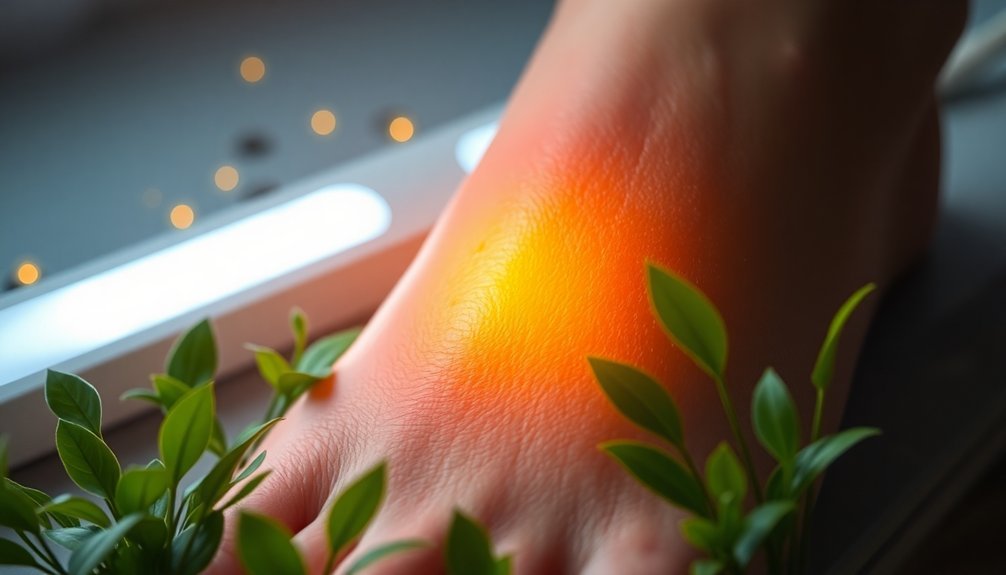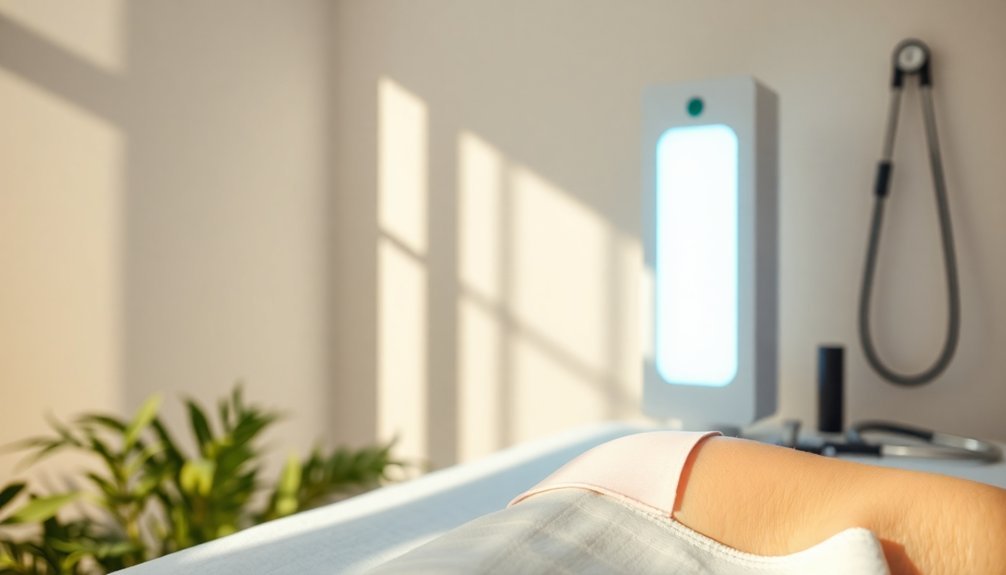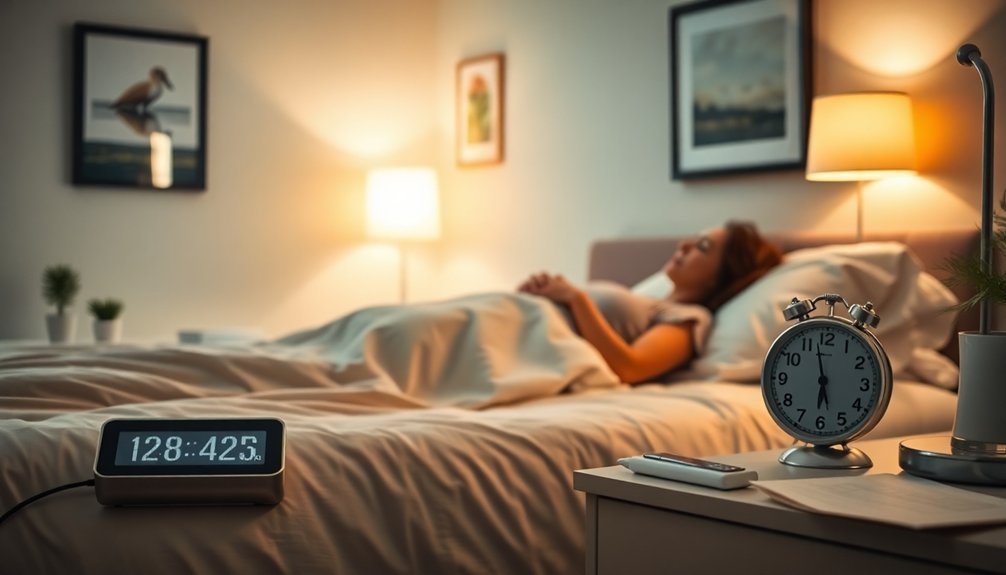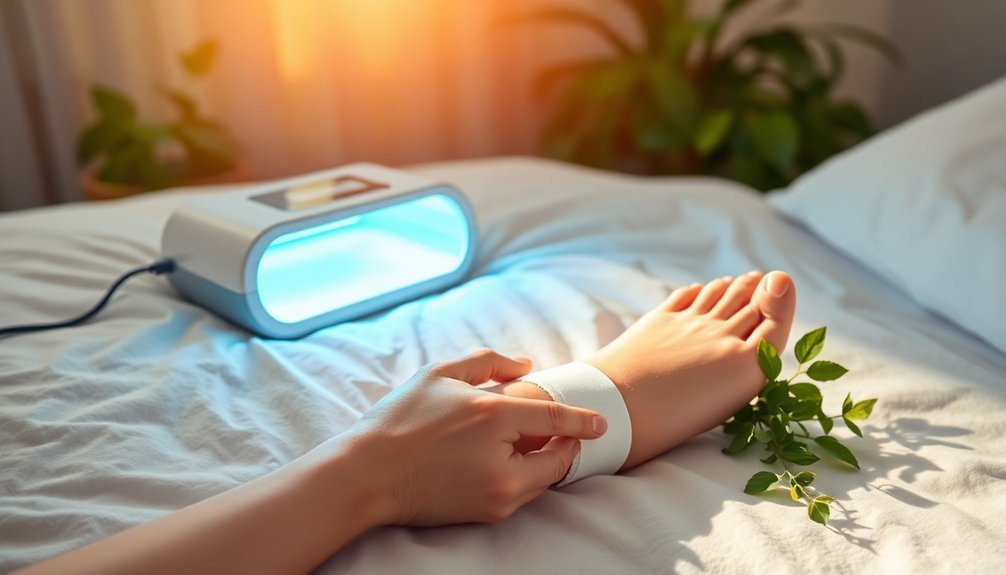For effective diabetic wound recovery with light therapy, start by choosing the right wavelength, ideally around 633 nm to enhance healing. Aim for 2-3 treatment sessions weekly for peak results; consistency is vital. Combine light therapy with standard care for improved outcomes, enhancing microcirculation. Monitor your progress regularly using tools to assess wound healing and adjust parameters as needed. Finally, guarantee your sessions are consistent, ideally lasting 6-15 minutes each. Following these tips will help propel your recovery. To discover additional insights, keep exploring what's available in light therapy techniques.
Choose the Right Wavelength

When it comes to optimizing light therapy for diabetic wound recovery, choosing the right wavelength is essential. Red light wavelengths of 633 nm and 635 nm are your best options, as they promote significant improvements in wound healing. This light penetrates deeper into your tissue, raising core body temperature and boosting blood flow to the wound site. Studies show that laser therapy at 633 nm can enhance healing by 38.5% to 53.4%. You'll notice increased cellular migration, viability, proliferation, and collagen production, all vital for wound recovery. For effective results, aim for a fluence of 2.35 J/cm², applied three times a week.
While green light at 540 nm also has some positive effects on wound healing, its impact isn't as pronounced as red light. It might help raise surface temperature and improve wound perfusion, but more research is needed to fully understand its benefits. Additionally, PBM can promote collagen synthesis and enhance granulation tissue formation, further supporting recovery. Be cautious and avoid wavelengths like blue light (470 nm), which have shown no effectiveness, and others like 730 nm and 980 nm that also fail to promote healing. Choosing the right wavelength can make all the difference in your recovery journey.
Optimize Treatment Frequency
Choosing the right wavelength for light therapy sets the stage for effective wound healing, but fine-tuning treatment frequency is equally important for achieving the best results.
To start, aim for 2-3 sessions per week for ideal outcomes. While daily sessions may work in some cases, they aren't always necessary. For diabetic burns specifically, three sessions weekly are highly recommended to aid recovery. It's important to consider that impaired wound healing in diabetic patients can often be attributed to factors like neuropathy and oxidative stress.
Keep in mind that the intervals between your sessions should remain consistent. In general, the number of sessions can vary greatly, ranging from 2 to 14 times weekly based on the wound's condition.
It's essential to continue treatment until the wound has healed fully, which could take several weeks or even months. Expect to commit to a minimum of 4-6 weeks for significant improvements.
Combine With Standard Care

Combining light therapy with standard wound care proves to be a powerful strategy for enhancing healing in diabetic wounds. When you integrate light therapy into your usual treatment protocols, you can greatly boost healing outcomes.
Common practices like conservative sharp debridement and off-loading will still play a vital role in your care plan, but adding light therapy can take your recovery to the next level.
You should aim to administer light therapy three times a week for eight weeks, using technologies like light-emitting diodes (LEDs) alongside traditional treatments such as 1% silver sulfadiazine cream. Studies have shown that this combination remarkably accelerates healing rates.
Blue light therapy can further enhance your results, assisting with the regeneration of healthy tissue and reducing the chance of infection. Moreover, applying red light therapy while adhering to standard care puts you in a better position for recovery. You'll notice improved microcirculation around the wound, leading to quicker healing and more notable granulation tissue formation. Receiving exclusive offers can also motivate you to pursue enhanced healing options.
Ultimately, integrating light therapy with standard care not only increases healing rates but can also lead to complete recovery in many chronic ulcer cases.
Monitor Patient Response
Monitoring patient response during light therapy is essential for enhancing recovery outcomes in diabetic wounds. You'll want to closely track various physiological changes and healing parameters to gauge the effectiveness of the treatment. Here are some key areas to focus on:
1. Physiological Changes
Use near-infrared spectroscopy (NIRS) to assess tissue oxygenation and total hemoglobin (totHb) concentration before and after treatment. This noninvasive approach helps evaluate blood flow improvements and autonomic nervous system activity.
2. Wound Healing Parameters
Regularly assess wound granulation using tools like the Falanga wound bed score. Document wound size, time to healing, and any presence of fibrin or wound fluid to measure the healing response.
3. Adjusting Therapy Parameters
Pay attention to how different light intensities and wavelengths affect recovery. Adjust the distance of the LED array from the wound, ensuring ideal light delivery for the best therapeutic effect.
Ensure Consistent Sessions

To achieve ideal results in diabetic wound recovery, ensuring consistent light therapy sessions is essential. You'll want to aim for treatments at least three times a week. Once you notice significant healing, you can switch to every other day. Irregular sessions can hinder your progress, so sticking to a routine is key.
Treatment Schedule Guidelines
| Session Frequency | Duration of Each Session | Additional Recommendations |
|---|---|---|
| 3-6 sessions per week | 6 to 15 minutes | Combine with standard wound care |
| Every other day (once healing observed) | 6 to 15 minutes | Continuous treatment until fully healed |
| Every day for 30 days | 6 to 15 minutes | Assess effectiveness after 2 months |
| 3 sessions per week | 6 to 15 minutes | Use specific wavelengths for healing |
| 2 sessions per week | 6 to 15 minutes | Consider combining with compression therapy |
Regularly engaging with therapy not only enhances healing but also supports your overall wound care strategy. Stick to your sessions, and you'll likely see better results in your recovery journey.
Frequently Asked Questions
Can Light Therapy Be Used Alongside Other Treatments for Diabetic Wounds?
Absolutely, you can use light therapy alongside other treatments for diabetic wounds. It enhances healing without interfering with standard practices like dressing changes, so it effectively complements topical treatments and medications you're already using.
What Are the Side Effects of Light Therapy for Wound Healing?
When using light therapy for wound healing, you might experience headaches, eye strain, or skin irritation. It's crucial to wear eye protection, start with shorter sessions, and consult a healthcare provider about potential medication interactions.
How Quickly Can I Expect Results From Light Therapy?
You can expect noticeable results from light therapy within 21 days. Many users experience faster healing and improved tissue regeneration shortly after starting treatment, making it an effective option for wound recovery. Stick with it!
Is Light Therapy Safe for All Types of Diabetic Wounds?
Yes, light therapy's safe for various diabetic wounds, including chronic, infected, and pressure ulcers. Just make sure you follow recommended parameters for ideal results. Always consult your healthcare provider to tailor the therapy to your needs.
Are There Any Specific Contraindications for Light Therapy Use?
Yes, there are specific contraindications for light therapy use, such as a history of cancer, pregnancy, or sensitive skin. Always consult a healthcare provider before starting treatment to ascertain it's safe for your individual situation.
In Summary
By following these five tips, you can greatly enhance diabetic wound recovery with light therapy. Choosing the right wavelength, optimizing how often you treat, and combining this therapy with conventional care will lead to better outcomes. Don't forget to monitor the patient's response and make certain sessions are consistent for maximum effectiveness. With a little attention to these details, you'll be on the right path to promoting faster healing and improved well-being for those in your care.





Leave a Reply